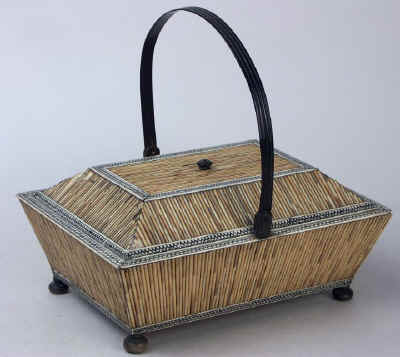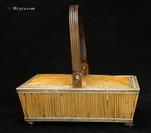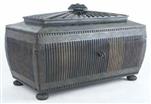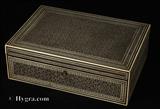|
| |
Antique Rare first period Anglo Indian Bombay Sadeli
mosaic box Circa 1800 with no restoration
Please click on images to enlarge | slide show | thumbnail index |
high resolution
|
Description:
Ref: 885JBAI http://hygra.com/box/885JBAI/
Antique rare first period
Anglo Indian box veneered all over with Sadeli mosaic, and
lined with sandalwood. The box in in incredible condition with no apparent
restorations.
The combination of the diverse patterns is a triumph
of artistic judgment, impeccable workmanship and deep respect for the
material in hand.
The boxes have an opulence emanating from the
richness of the materials, yet the total control of these materials
and the cerebral nature of the overall designs give them a restrained
dignity.
The makers (reputed to be Persian)
of Sadeli mosaic made in the first two decades of the 19th century
displayed a total understanding of the qualities of the different
materials they used.
Origin: India Bombay
Circa: 1800
Materials: see
description.
Sadeli mosaic
on a rosewood structure, and lined with sandalwood.
Size: 25.8 cm wide by 17.8 cm by 8.5 cm: 10.2
inches wide
by 7 inches by 3.4 inches.
Condition: very good
overall; no repairs; working lock and key; see images, both photos and
scans.
Keywords: Hygra.com, Antique
box, Sadeli mosaic, Anglo Indian sandalwood,
micro mosaic, Bombay, Circa 1800
Request
current list of available sewing boxes with prices.
Request
current list of available writing boxes with prices.
Request
current list of available jewelry boxes with prices.
Request
current list of available tea caddies with prices.
boxes@hygra.com
|
 (Small).JPG)
This box has not been restored; all the inlays are in the places
laid.
It gives an insight into the order of build.
The inlay is first made
in strips.
These were expensive to make = The wages for how many workers and for
how long?
I am still working on it!
The import costs of the materials .
The sandalwood was from the Malabar Coast and sold on the Bombay market
according to weight.
The ebony came from Malabar and Ceylon.
The Ivory used in sadeli was principally African and was
shipped to india from Zanzibar.
see:
Furniture
from British India and Ceylon: A Catalogue of the Collections in the V
& A and the Peabody Essex Museum, Amin Jaffer ISBN:
1851773185
Antique
Boxes, Tea Caddies, and Society, 1700--1880
Antigone Clarke & Joseph O'Kelly, ISBN: 0764316885
|

 (Small).JPG)
|
The use of large expanses of sadeli mosaic was soon
abandoned on account of the technical difficulties of making it.
The combination of the diverse patterns is a triumph of artistic
judgment, impeccable workmanship and deep respect for the material in
hand.
The boxes have an opulence emanating from the richness of the
ingredients, yet the total control of these materials and the cerebral
nature of the overall designs give them a restrained dignity.
|
Please click on images to enlarge | slide show | thumbnail index |
 (Small).JPG)
|
The box is covered in Sadeli mosiac.
The ancient art of Sadeli Mosaic
is said to have been introduced from Shiraz in Persia via Sind to
Bombay, a long time before the Anglo Indian boxes were made. It was a
technique, which required a high degree of skill and patience. It was
executed very lavishly, in that the frequent cuts wasted a great amount
of the precious materials used. The workmanship was however more than
commensurable to the value of the materials.
This type of work was highly valued in
England. Queen Charlotte (1744-1818) had three sadeli boxes in
her collection.
See: http://www.hygra.com/anglo.html#3
|
The mosaic is composed of triangular elements of pewter,
ivory, stained ivory, ebony and rosewood.
In the early boxes, which date from the
turn of the 18th to the 19th century, there are large panels of mosaic
covering tops and sides of boxes.
It took incredible skill to cover such
large areas without any shakes or wavering of the pattern. The corners and
joins on these boxes are impeccably matched.
|
 (Small).JPG)
|
Please click on images to enlarge | slide show | thumbnail index |
Sandalwood is easily identifiable by its wonderful smell
which is still vibrant.
|
 (Small).JPG)
|
 (Small).JPG)
|
The key is probably circa 1850. |
Please click on images to enlarge | slide show | thumbnail index |
 (Small).JPG)
|
There are a few cracks in the sandalwood panel on the back of the
lid.
|
The Bombay makers (reputed to be
Persian) of Sadeli mosaic made in the first two decades of the 19th
century displayed a total understanding of the qualities of the different
materials they used.
They combined substances, which can
expand and contract according to atmospheric conditions with others, which
are hard and unyielding.
The result was a sharp definition of the
lines and patterns, which made up the whole design.
|
 (Small).JPG)
|
 (Small).JPG)
|
On the early boxes such as
this, the
designs look deceptively simple.
The fact is, the patterns and designs emerged from a culture,
which had mastered geometry and understood how to generate a pattern from
a set number of points. The patterns are so harmoniously combined that
their incredible complexity is not immediately apparent.
The earliest Sadeli boxes are of simple
rectangular shapes.
The combination of the diverse patterns is a triumph
of artistic judgment, impeccable workmanship and deep respect for the
material in hand.
The boxes have an opulence emanating from the richness
of the materials, yet the total control of these materials and the
cerebral nature of the overall designs give them a restrained
dignity.
These early Sadeli boxes are now very rare indeed.
|
Please click on images to enlarge | slide show | thumbnail index |
 (Small).JPG)
|
Photograph of top; there is a
scan below.
|
Photograph of front;
there is a scan below.
|
 (Small).JPG)
|
Photograph of side;
there is a scan below.
|
 (Small).JPG)
|
Please click on images to enlarge | slide show | thumbnail index |
 (Small).JPG)
|
Photograph of back;
there is a scan below. |
 (Small).JPG)
|
Photograph of side;
there is a scan below. |
Please click on images to enlarge | slide show | thumbnail index |
Photograph of
bottom;
|
 (Small).JPG)
|
 (Small).JPG)
|
Scan of Front; there
is a photo further up. |
Please click on images to enlarge | slide show | thumbnail index |
 (Small).JPG)
|
Scan of side; there is a
photo further up.
|
Scan of side; there
is a photo further up.
|
 (Small).JPG)
|
Scan of top; there
is a photo further up.
|
 (Small).JPG)
|
Please click on images to enlarge | slide show | thumbnail index |
 (Small).JPG)
|
Scan of back; there
is a photo further up.
|
Please click on images to enlarge | slide show | thumbnail index |
References:
See Antique Boxes Tea Caddies Society
See: Furniture from British India and Ceylon Amin Jaffir
See: Luxury Goods from India: The Art of the Indian Cabinet-maker Amin Jaffer 2002
Other Anglo Indian boxes:
Below are some Anglo-Indian- boxes I have
documented on our site. It is becoming increasingly hard to find examples which
have survived with their integrity

 


 

.thumb.JPG)

.thumb.JPG)



All text and images and linked images are ©
1999-2016 Antigone Clarke and Joseph O'Kelly. If you require any further
information on permitted use, or a licence to republish any material, email us
at copyright@hygra.com
|
